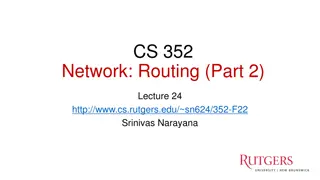Efficient Truck Routing Program for Parcel Delivery
Create a program to efficiently route trucks for delivering parcels between cities, optimizing for cost and time constraints. Consider factors like waiting times, travel costs, and parcel payoff. Use shortest paths and implement necessary algorithms for effective truck routing.
Download Presentation

Please find below an Image/Link to download the presentation.
The content on the website is provided AS IS for your information and personal use only. It may not be sold, licensed, or shared on other websites without obtaining consent from the author.If you encounter any issues during the download, it is possible that the publisher has removed the file from their server.
You are allowed to download the files provided on this website for personal or commercial use, subject to the condition that they are used lawfully. All files are the property of their respective owners.
The content on the website is provided AS IS for your information and personal use only. It may not be sold, licensed, or shared on other websites without obtaining consent from the author.
E N D
Presentation Transcript
RACE CONDITIONS AND SYNCHRONIZATION Lecture 22 CS2110 Spring 2015
Assignment A8: Shipping Game 2 In a nut shell: Bunch of cities with roads between them (a graph) Parcels sitting at cities, have to be trucked to other cities Trucks, all at a city called Truck Depot, have to be used to move each parcel from its start city to its destination city. Then return Trucks to the Home Depot YOU have to write the program that tells the Trucks what to do! Efficiency is important! Use shortest paths where possible. We DEMO A8
Assignment A8: Shipping Game 3 Assignment A8 is developed Michael (Shnik) Patashnik Undergrad TA A&S, studying Economics and CS Other CS2110 staff involved: Eric Chahin, Alex Fusco, Aaron Nelson, Alexandra Anderson. Which one of you will be the next one to help us develop our assignments?
A8 Efficiency 4 You want to get the best score possible! How much you do, what you do, depends your time constraints, your abilities, whether your find this assignment fun. Here are things to consider. It costs for a Truck to wait It costs for a Truck to travel It costs for a Truck to pick up and drop a Parcel A LOT is gained by dropping a Parcel at its destination Parcel Payoff is a LOT more if the truck that delivers it has the same color as the Parcel.
Ideas for A8 5 Spend a lot of time thinking about the design, looking at specs of Truck, Parcel, manager, etc. Look at class diagram on page 7 of the handout. Given a truck that has to pickup a Parcel, need to find a quickest/shortest path to where Parcel is. Dfs and bfs won t do. Probably need a version of shortest-path algorithm from a start node to another. Each Truck has a field UserData in which you can store anything you wish. E.g. a path from current location to destination of the Parcel it is carrying. Each Parcel also has a UserData field
You class MyManager extends game.Manager 6 We don t give you Java source files. We give you only the .class files and good specs of the classes. Specs are in Data/doc We demo looking at API specs
Your main task 7 public class YourManager extends Manager { public @Override void run() { Look at map, parcels truck, do preprocessing and give Trucks their initial instructions } public @Override void truckNotification(Truck t, Notification message) { Called when event happens with Truck t it waited to long and is prodding, it arrived at a city, there s a parcel at the city, etc. This method should give the truck directions on how to proceed. }
Manager and trucks run in their own threads 8 public class YourManager extends Manager { public @Override void run() { } public @Override void truckNotification(Truck t, Notification msg) { ... } } Make sure shared variables don t cause problems. E.g. Two Trucks try to take the same Your manager Truck 1 Truck 2 thread thread thread Parcel
Threads and synchronization in A8 9 A lot of synchronization happens behind the scenes in A8: The manager that you write is a Thread. Each Truck is a Thread. Depending on your implementation, you may or may not have to use synchronization primitives in your part. Most of you will not use synchronized blocks at all. Just be careful and ask yourself whether concurrency can cause problems. E.g. can two trucks try to pick up the same Parcel at the same time?
Your method run(): Preprocessing 10 for Parcel p do Choose a truck t to deliver p. Store p in a data structure in t s user data. end How to choose? It s up to you. How to store data? It s up to you.
Your truckNotification(Truck t, Notification msg) 11 Remember: several threads (Trucks) may be executing this at the same time. If shared data structures used, must make sure concurrency doesn t create problems // Always start with first if if preprocessing not done then return; if there are no Undelivered Parcels then Route t home and return; if t holding a parcel then Route t to parcel s destination, drop it off if there else Find next parcel assigned to t, route to that parcel Truck t calls this method to say that it has done something or it is waiting for further instructions.
Reminder 12 A race condition arises if two threads try and share some data One updates it and the other reads it, or both update the data In such cases it is possible that we could see the data in the middle of being updated A race condition : correctness depends on the update racing to completion without the reader managing to glimpse the in-progress update Synchronization (aka mutual exclusion) solves this
Java Synchronization (Locking) 13 private Stack<String> stack = new Stack<String>(); public void doSomething() { synchronized (stack) { if (stack.isEmpty()) return; String s = stack.pop(); } //do something with s... } synchronized block Put critical operations in a (short) synchronized block The stack object acts as a lock Only one thread can own the lock at a time
Synchronization on Objects 14 Mutually exclusive synchronized (foo) { // something } synchronized (foo) { // something else } Not mutually exclusive Not mutually exclusive synchronized (bar) { ... }
Synchronization on Objects 15 synchronized (foo) { // something } Not mutually exclusive { // unsynchronized code }
Java Synchronization (Locking) 16 You can lock on any object, including this public synchronized void doSomething() { ... } is equivalent to public void doSomething() { synchronized (this) { ... } }
How locking works 17 Only one thread can hold a lock at a time If several request the same lock, Java somehow decides which will get it The lock is released when the thread leaves the synchronization block synchronized(someObject) { protected code } The protected code has a mutual exclusion guarantee: At most one thread can be in it When released, some other thread can acquire the lock
Locks are associated with objects 18 Every Object has its own built-in lock Just the same, some applications prefer to create special classes of objects to use just for locking This is a stylistic decision and you should agree on it with your teammates or learn the company policy if you work at a company Code is thread safe if it can handle multiple threads using it otherwise it is unsafe
Visualizing deadlock 19 A has a lock on X wants a lock on Y Process A Process B X Y B has a lock on Y wants a lock on X
Deadlocks always involve cycles 20 They can include 2 or more threads or processes in a waiting cycle Other properties: The locks need to be mutually exclusive (no sharing of the objects being locked) The application won t give up and go away (no timer associated with the lock request) There are no mechanisms for one thread to take locked resources away from another thread no preemption http://t2.gstatic.com/images?q=tbn:wgSGQBtjyvSU0M:http://julesfredrick.files.wordpress.com/2009/10/cat-robbery.jpg ... drop that mouse or you ll be down to 8 lives
Dealing with deadlocks 21 We recommend designing code to either Acquire a lock, use it, then promptly release it, or ... acquire locks in some fixed order Example, suppose that we have objects a, b, c, ... Now suppose that threads sometimes lock sets of objects but always do so in alphabetical order Can a lock-wait cycle arise? ... without cycles, no deadlocks can occur!
Higher level abstractions 22 Locking is a very low-level way to deal with synchronization Very nuts-and-bolts So, many programmers work with higher level concepts. Sort of like ADTs for synchronization We ll just look at one example today There are many others; take cs4410 to learn more
A producer/consumer example 23 Thread A produces loaves of bread and puts them on a shelf with capacity K For example, maybe K=10 Thread B consumes the loaves by taking them off the shelf Thread A doesn t want to overload the shelf Thread B doesn t wait to leave with empty arms http://t3.gstatic.com/images?q=tbn:GkHvFuCiJdMxJM:http://calorielab.com/news/wp-images/post-images/french-bakery-breads-and-pastries.jpg See full size image http://t0.gstatic.com/images?q=tbn:AiboYT8upHBwGM:http://www.ciaprochef.com/fbi/images/podcasts/breadBaker/Bread-%26-Baker.jpg shelves consumer producer
Producer/Consumer example 24 class Bakery { int nLoaves = 0; // Current number of waiting loaves final int K = 10; // Shelf capacity public synchronized void produce() { while(nLoaves == K) this.wait(); // Wait until not full ++nLoaves; this.notifyall(); // Signal: shelf not empty } public synchronized void consume() { while(nLoaves == 0) this.wait(); // Wait until not empty --nLoaves; this.notifyall(); // Signal: shelf not full } }
Things to notice 25 Wait needs to wait on the same object that you used for synchronizing (in our example, this , which is this instance of the Bakery) Notify wakes up just one waiting thread, notifyall wakes all of them up We used a while loop because we can t predict exactly which thread will wake up next
Bounded Buffer 26 Here we take our producer/consumer and add a notion of passing something from the producer to the consumer For example, producer generates strings Consumer takes those and puts them into a file Question: why would we do this? Keeps the computer more steadily busy
Producer/Consumer example 27 class Bakery { int nLoaves = 0; // Current number of waiting loaves final int K = 10; // Shelf capacity public synchronized void produce() { while(nLoaves == K) this.wait(); // Wait until not full ++nLoaves; this.notifyall(); // Signal: shelf not empty } public synchronized void consume() { while(nLoaves == 0) this.wait(); // Wait until not empty --nLoaves; this.notifyall(); // Signal: shelf not full } }
Bounded Buffer example 28 class BoundedBuffer<T> { int putPtr = 0, getPtr = 0; // Next slot to use int available = 0; // Items currently available final int K = 10; // buffer capacity T[] buffer = new T[K]; public synchronized void produce(T item) { while(available == K) this.wait(); // Wait until not full buffer[putPtr++ % K] = item; ++available; this.notifyall(); // Signal: not empty } public synchronized T consume() { while(available == 0) this.wait(); // Wait until not empty --available; T item = buffer[getPtr++ % K]; this.notifyall(); // Signal: not full return item; } }
In an ideal world 29 Bounded buffer allows producer and consumer to both run concurrently, with neither blocking This happens if they run at the same average rate and if the buffer is big enough to mask any brief rate surges by either of the two But if one does get ahead of the other, it waits This avoids the risk of producing so many items that we run out of computer memory for them. Or of accidentally trying to consume a non-existent item.
Trickier example 30 Suppose we want to use locking in a BST Goal: allow multiple threads to search the tree But don t want an insertion to cause a search thread to throw an exception
Code were given is thread unsafe class BST { Object name; // Name of this node Object value; // Value of associated with that name BST left, right; // Children of this node 31 // Constructor public void BST(Object who, Object what) { name = who; value = what; } // Returns value if found, else null public Object get(Object goal) { if(name.equals(goal)) return value; if(name.compareTo(goal) < 0) return left==null? null: left.get(goal); return right==null? null: right.get(goal); } // Updates value if name is already in the tree, else adds new BST node public void put(Object goal, Object value) { if(name.equals(goal)) { this.value = value; return; } if(name.compareTo(goal) < 0) { if(left == null) { left = new BST(goal, value); return; } left.put(goal, value); } else { if(right == null) { right = new BST(goal, value); return; } right.put(goal, value); } } }
Attempt #1 32 Just make both put and get synchronized: public synchronized Object get( ) { } public synchronized void put( ) { } Let s have a look .
Safe version: Attempt #1 class BST { Object name; // Name of this node Object value; // Value of associated with that name BST left, right; // Children of this node 33 // Constructor public void BST(Object who, Object what) { name = who; value = what; } // Returns value if found, else null public synchronized Object get(Object goal) { if(name.equals(goal)) return value; if(name.compareTo(goal) < 0) return left==null? null: left.get(goal); return right==null? null: right.get(goal); } // Updates value if name is already in the tree, else adds new BST node public synchronized void put(Object goal, object value) { if(name.equals(goal)) { this.value = value; return; } if(name.compareTo(goal) < 0) { if(left == null) { left = new BST(goal, value); return; } left.put(goal, value); } else { if(right == null) { right = new BST(goal, value); return; } right.put(goal, value); } } }
Attempt #1 34 Just make both put and get synchronized: public synchronized Object get( ) { } public synchronized void put( ) { } This works but it kills ALL concurrency Only one thread can look at the tree at a time Even if all the threads were doing get !
Visualizing attempt #1 35 Get(Martin) resumes Put(Ernie, eb0) Freddy netid: ff1 Get(Martin) must wait! Martin mg8 Cathy cd4 Andy am7 Darleen dd9 Zelda za7 Ernie eb0
Attempt #2 36 put uses synchronized in method declaration So it locks every node it visits get tries to be fancy: // Returns value if found, else null public Object get(Object goal) { synchronized(this) { if(name.equals(goal)) return value; if(name.compareTo(goal) < 0) return left==null? null: left.get(goal); return right==null? null: right.get(goal); } } Actually this is identical to attempt 1! It only looks different but in fact is doing exactly the same thing
Attempt #3 37 // Returns value if found, else null public Object get(Object goal) { boolean checkLeft = false, checkRight = false; synchronized(this) { if(name.equals(goal)) return value; if(name.compareTo(goal) < 0) { if (left==null) return null; else checkLeft = true; } else { if(right==null) return null; else checkRight = true; } } if (checkLeft) return left.get(goal); if (checkRight) return right.get(goal); relinquishes lock on this next lines are unprotected /* Never executed but keeps Java happy */ return null; } Risk: get (read-only) threads sometimes look at nodes without locks, but put always updates those same nodes. According to JDK rules this is unsafe
Attempt #4 38 // Returns value if found, else null public Object get(Object goal) { BST checkLeft = null, checkRight = null; synchronized(this) { if(name.equals(goal)) return value; if(name.compareTo(goal) < 0) { if (left==null) return null; else checkLeft = left; } else { if(right==null) return null; else checkRight = right; } } if (checkLeft != null) return checkleft.get(goal); if (checkRight != null) return checkright.get(goal); /* Never executed but keeps Java happy */ return null; } This version is safe: only accesses the shared variables left and right while holding locks In fact it should work (I think)
Attempt #3 illustrates risks 39 The hardware itself actually needs us to use locking and attempt 3, although it looks right in Java, could actually malfunction in various ways Issue: put updates several fields: parent.left (or parent.right) for its parent node this.left and this.right and this.name and this.value When locking is used correctly, multicore hardware will correctly implement the updates But if you look at values without locking, as we did in Attempt #3, hardware can behave oddly!
More tricky things to know about 40 With priorities Java can be very annoying ALWAYS runs higher priority threads before lower priority threads if scheduler must pick The lower priority ones might never run at all Consequence: risk of a priority inversion High priority thread t1 is waiting for a lock, t2 has it Thread t2 is runnable, but never gets scheduled because t3 is higher priority and busy
Summary 41 Use of multiple processes and multiple threads within each process can exploit concurrency Which may be real (multicore) or virtual (an illusion) But when using threads, beware! Must lock (synchronize) any shared memory to avoid non- determinism and race conditions Yet synchronization also creates risk of deadlocks Even with proper locking concurrent programs can have other problems such as livelock Serious treatment of concurrency is a complex topic (covered in more detail in cs3410 and cs4410) Nice tutorial at http://docs.oracle.com/javase/tutorial/essential/concurrency/index.html























